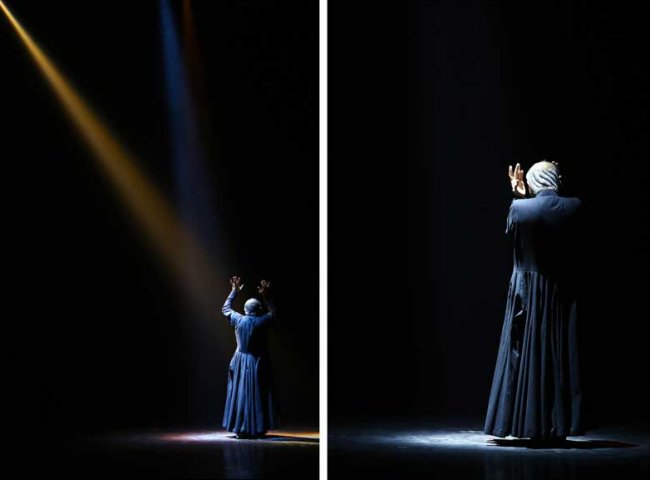
|   |

|   |
 e-mail: sunilkothari1933@gmail.com Astad Deboo's Eternal Embrace Photos: Ritam Banerjee December 15, 2016 During the contemporary dance festival at NCPA, Mumbai, Astad Deboo premiered his latest work Eternal Embrace for two nights (Dec 9 & 10, 2016) to live music by Japanese musician Yukio Tsuji.  Eternal Embrace is based on Hazrat Bulleh Shah's Maati. Bulleh Shah uses the word in its meaning of something ephemeral and mortal, much like the word dust or clay is used in English to convey the transience of the material world. Astad mentions in his choreographer's note that in this kafi (a form of Sufi poetry meant to be sung), Bulleh Shah marvels at the way the world acts despite the certainty of ultimate annihilation. Astad likes this beautiful poem a lot. Whenever Astad feels lost in worldly problems, he recalls these verses and immediately finds his centre. He has curtailed the use of the refrain in the translation, opting to use it only once at the beginning instead of multiple times in the original. He has published Hazrat Bulleh Shah's poetry, in Roman script, which is fascinating. If one listens to it sung by some musician, its impact is felt intensely. Maati jora, maati ghora, maati da aswaar, the images of horse and the rider and so on. If one listens carefully, Yukio Tsuji often pronounces Maati, Maati and it has also a mystical evocation. The excellent lighting by Bhairavi and costume by Archana Shah, show the performer in dim light, a mere outline, moving in extremely slow, almost imperceptibly, creating further mystical feeling, with long black skirt and dancer bending. The music with Shakuhachi flute creates the mood.  At his age, Astad has an amazing control over the instrument, his body. His movements are subtle. There is a quality of prayer. Suggestions of dust, clay, soil are conveyed through movements of hands, palms and bowing to earth, ground with quintessential music, silences, pauses, sounds. Yukio also handles drums as per the mood and movements. The perfect understanding between the dancer and the musician is the result of long practice. None seems to over ride. They go hand in hand with deep feeling. The audience watches in complete silence. Slowly movements gather momentum. When face is lit up, expressions are seen, of humility, surrender, arms, palms speaking in gentle tones. At times they are spasmodic in nature, body suddenly turning, long skirt flying, the pirouette enhancing the change. Circling is seen conveying joy. When bending, the musician explores silence. At one point one listened to sound of a downpour, slashing rains and words maati, maati, maati. The abstraction was excellent. Legs held apart, body bending, palms crossed, sometimes words and a phrase of poem are heard and one experiences the spiritual quality. The intensity of the work is palpable. So many sounds, in the beginning chirping of birds, arms moving joyously on either side, drawing arcs, dancer gliding, and once reminiscent of Bolero music to which dancer making circles creates hypnotic movement, but controlled and not overdone. The pirouettes are unlike Sufi pirouettes. I am tempted to say they are special whirlings of Astad, inimitable, drawing from his early training in Kathak. Astad's early work with boundless chakkars has his singular signature. Here he has shown restraint and it appears apt, and does not lead audience to want it more. The finale is poetic, the Hindi proverb Mitti se aya mitti me mil jayega - what came from dust shall meet in dust. The dancer slowly bows, with tremendous control and lies down on floor like foetus in a womb. The original poem says Maati paaon pasaar, Lah sirr bhoyin maar - loosely translated it means head touching ground, feet immersed in dust, the ultimate merging with the soil. A thoroughly moving piece.  A lot of thinking has gone behind this work. Astad has said in one of his interviews, about how after a long time he has choreographed one hour long piece. Not exactly to look like Sufi dervishes and their chakkars, but deeply felt emotions, which touch the hearts of the audiences, and the meaningful collaboration with musician on the stage in one corner conducting music, playing instruments and the two working together like one being. One has watched Astad in his several explorations for nearly fifty years and one is astounded by his pursuit, like what Tagore says: Ekla Chalo Ekla Chalo, move alone, move alone. Astad's dance journey is of such nature. Often someone asks about his legacy and he says his work cannot be copied, he has taught to a few and they have danced independently with their own understanding. He is a loner and has continued creating. I feel that Astad has no regrets or desire that his legacy has to be carried on. He is a much realized soul and finds happiness in his dancing, touching his diverse audiences world over.  Dr. Sunil Kothari is a dance historian, scholar, author and critic. He is honored with Padma Shri, Sangeet Natak Akademi award and Senior Critic Award from Dance Critics Association, NYC. Post your comments Please provide your name and email id when you use the Anonymous profile in the blog to post a comment. All appropriate comments posted with name & email id in the blog will also be featured in the site. |